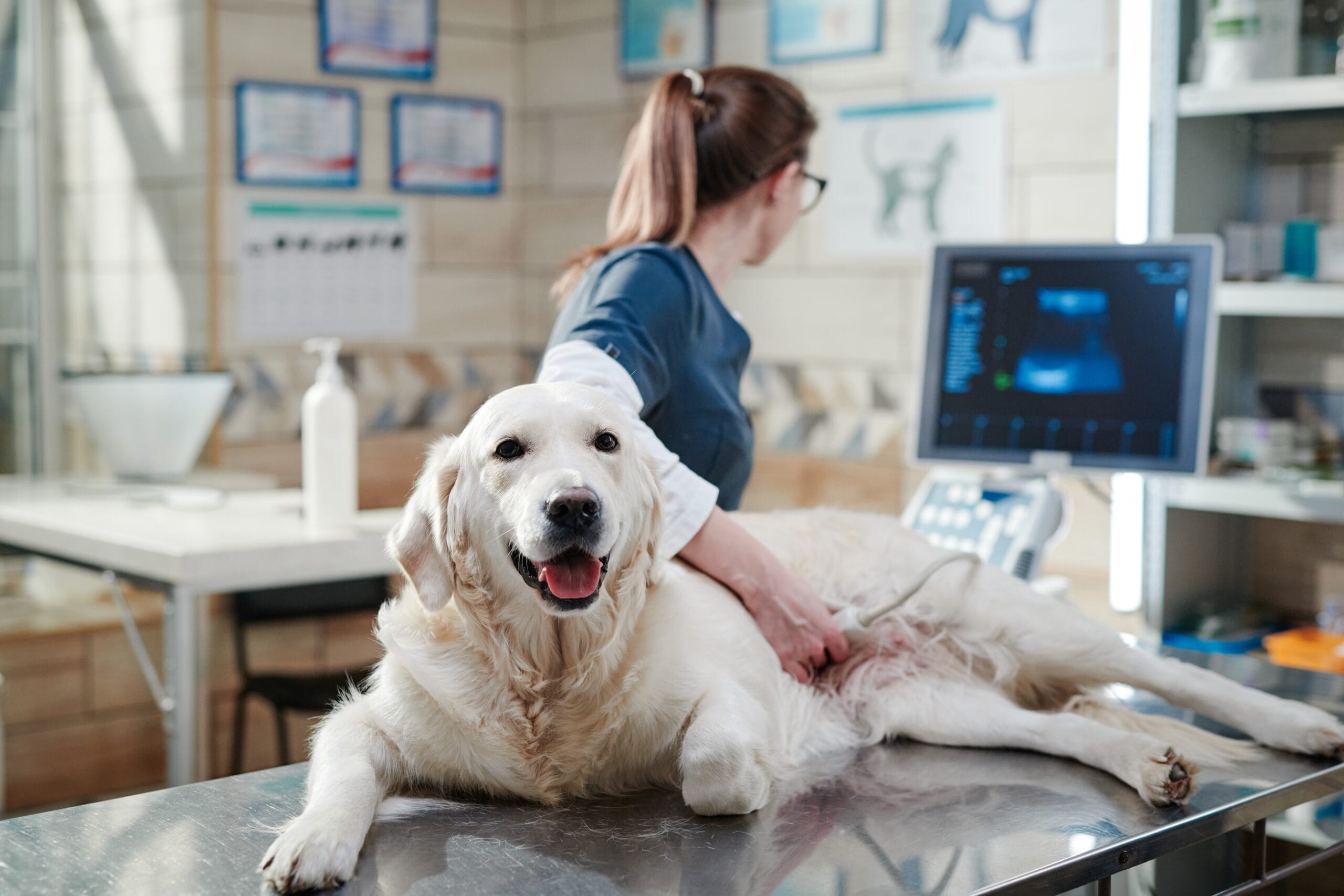If you’re a dog breeder or an expectant pet parent, knowing when puppies become visible on ultrasound can help you prepare for the exciting journey ahead. Understanding the timeline of fetal development through ultrasound imaging provides crucial insights into your dog’s pregnancy and helps ensure the health of both mother and puppies.
From the earliest signs of pregnancy to the final stages before whelping, ultrasound technology plays a vital role in monitoring canine pregnancy. We’ll guide you through each stage of development and what you can expect to see during your dog’s ultrasound examinations.
Understanding Dog Ultrasounds
A dog ultrasound is a non-invasive imaging technique that uses high-frequency sound waves to create detailed pictures of your dog’s internal organs and developing puppies. Unlike X-rays, ultrasounds don’t use radiation, making them completely safe for both the mother and her developing puppies. Your veterinarian will apply a special gel to your dog’s abdomen and use a handheld device called a transducer to generate real-time images of the pregnancy.
Signs You Need a Dog Ultrasound
- Suspected Pregnancy: If your pet has been bred, a dog ultrasound can confirm pregnancy as early as 20-25 days after breeding. This early detection helps you prepare for the upcoming changes and responsibilities.
- Changes in Physical Appearance: When you notice your pet’s abdomen enlarging or her nipples becoming more prominent, a dog ultrasound can confirm whether these changes are pregnancy-related.
- Abnormal Vaginal Discharge: Any unusual discharge during suspected pregnancy should be evaluated with a dog ultrasound to ensure the health of both mother and puppies.
- Changes in Appetite or Behavior: If your pregnant pet shows significant changes in eating habits or behavior, a dog ultrasound can help identify any potential complications.
- Pre-whelping Assessment: A final dog ultrasound in late pregnancy helps determine puppy positions and estimates the timing for whelping.
Timeline of Puppy Development on Ultrasound
Early Stage Detection (20-30 Days)
During the early stage of pregnancy, your veterinarian will perform the first dog ultrasound to confirm pregnancy and assess initial development. At this stage, the gestational sacs appear as dark, fluid-filled circles within the uterus. This crucial first look helps establish a baseline for monitoring the pregnancy’s progression.
Visible structures:
- Small, round gestational sacs
- Early fetal movement (sometimes visible by day 28)
- Fetal heartbeats (detectable around day 25)
- Initial placental development
- Basic uterine changes
Mid-Pregnancy Imaging (30-45 Days)
The mid-pregnancy period reveals significant development in puppy size and structure. During this stage, individual puppies become more clearly defined, and your veterinarian can better assess fetal growth and vitality. The dog ultrasound images show more detailed anatomical features.
Observable developments:
- Distinct puppy outlines
- Clear fetal heartbeats
- Spine and skeletal formation
- Head and body differentiation
- Initial organ development
- Active fetal movement
Late-Stage Development Visibility (45+ Days)
In the final stages of pregnancy, dog ultrasound imaging provides detailed views of fully formed puppies. While counting exact numbers becomes more challenging due to puppy size and position, these late-stage scans are crucial for assessing fetal health and preparing for whelping.
Key observations:
- Complete skeletal structure
- Detailed internal organs
- Active puppy movements
- Fetal positioning
- Placental health assessment
- Signs of impending labor
What to Expect During a Dog Ultrasound
Before performing your dog’s ultrasound, your veterinarian will conduct an initial consultation to review your pet’s medical history and breeding timeline. This consultation helps determine the optimal timing for the ultrasound and allows you to share any concerns about your dog’s pregnancy. Your vet will also explain the dog ultrasound process and answer any questions you may have about the procedure.
- Preparation: Your dog’s abdomen will be shaved to ensure clear contact between the ultrasound probe and the skin. This small patch of shaving is necessary for optimal image quality.
- Positioning: Your dog will be gently positioned on their back or side in a comfortable position. Some clinics provide a specially designed cushioned table or support system.
- Gel Application: A warm, water-based gel will be applied to your dog’s abdomen. This gel helps transmit the sound waves and improves image quality.
- Scanning: The veterinarian will move the ultrasound probe across your dog’s abdomen, capturing images of the developing puppies from different angles.
- Image Review: Your veterinarian will explain what they’re seeing on the screen, pointing out key features and development markers.
- Documentation: Important images will be saved for your dog’s medical record and to track pregnancy progression in future visits.
- Clean-up: The gel will be wiped away, and your dog can return to their normal activities immediately after the procedure.
The typical dog ultrasound session lasts between 20-30 minutes, depending on the stage of pregnancy and the number of puppies. For a normal pregnancy, you can expect to have 3-4 ultrasound examinations throughout the gestation period. Your veterinarian will schedule these appointments at key developmental stages to ensure optimal monitoring of both mother and puppies.
Monitoring Fetal Health Through Ultrasound
During each dog ultrasound examination, your veterinarian will take specific measurements to track fetal development. These include measuring gestational sac size in early pregnancy, crown-to-rump length during mid-pregnancy, and head diameter in late pregnancy. These measurements help confirm proper growth rates and can alert your veterinarian to any developmental concerns.
Common Concerns and Warning Signs of Potential Issues
- Irregular Heartbeats: Fetal heart rates should maintain a steady rhythm between 200-250 beats per minute. Any significant deviation may indicate distress.
- Growth Discrepancies: Puppies should grow at similar rates. Significant size differences between the upcoming litter may signal developmental issues.
- Reduced Movement: Decreased fetal activity or lack of movement during examination could indicate fetal distress.
- Abnormal Fluid Levels: Too much or too little amniotic fluid can affect puppy development and may require intervention.
- Placental Abnormalities: Changes in placental appearance or attachment could impact nutrient delivery to puppies.
A typical pregnancy monitoring schedule includes ultrasounds at key developmental stages around 25, 35, and 45 days after breeding. Your veterinarian may recommend additional scans based on your dog’s health history or if any concerns arise during the pregnancy. This schedule ensures consistent monitoring while minimizing stress on the mother.
From Ultrasound to Whelping: Preparing for Birth
Your dog’s ultrasound measurements play a crucial role in predicting when she’ll give birth. By tracking fetal development and litter size through sequential ultrasounds, your veterinarian can estimate the whelping date with remarkable accuracy. This information helps you prepare your whelping area and ensure you’re ready when labor begins, typically 63 days after breeding, though this can vary by a few days.
Position Assessment and Birth Planning
Understanding your puppies’ positions in the final weeks of pregnancy helps prepare for a smooth delivery. Your veterinarian will use ultrasound imaging to assess the positioning of the puppies and develop a comprehensive birth plan.
- Initial Assessment: The veterinarian examines the position of each puppy relative to the birth canal. Proper positioning shows puppies aligned head-first or rear-first.
- Birth Order Planning: Creating a rough map of puppy positions helps anticipate the delivery sequence and identify potential complications.
- Space Evaluation: Your vet will assess whether there’s adequate space in the birth canal for normal delivery.
- Emergency Preparation: Based on position assessment, your vet will determine if a C-section might be necessary and prepare accordingly.
Signs of Approaching Labor
- Temperature Changes: Monitor your dog’s temperature regularly. A drop below 100°F (37.8°C) often indicates labor will begin within 24 hours.
- Behavioral Changes: Your dog may become restless, start nesting, or show reduced appetite 12-24 hours before labor begins.
- Physical Changes: Look for visible contractions and straining. These are clear signs that active labor has begun.
- Initial Stage: Clear or slightly bloody discharge may appear, signaling the start of early labor.
- Active Labor: Strong, regular contractions indicate the transition to active labor. Puppies typically arrive 20-60 minutes apart.
Conclusion
Regular dog ultrasound monitoring throughout pregnancy provides crucial insights into your puppies’ development and helps ensure a successful whelping process. From early detection to final positioning, each ultrasound scan offers valuable information that guides your veterinary team in providing the best care for your expecting dog.
Ready to schedule your dog’s pregnancy ultrasound? Contact Insight Veterinary Wellness Center today to begin your journey toward a healthy delivery. Stay connected with us on Facebook, Instagram, YouTube, and TikTok for more helpful tips on pet pregnancy care and general wellness information. Our experienced team is here to support you every step of the way.






